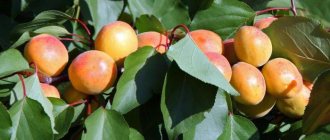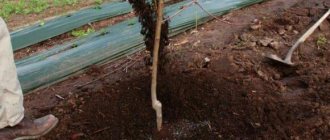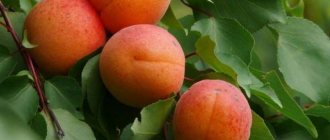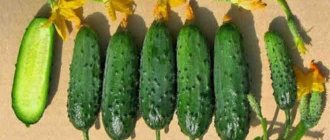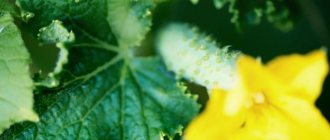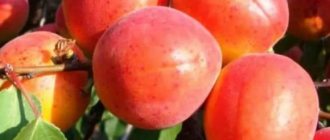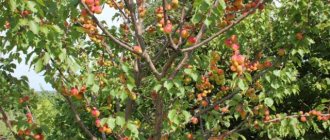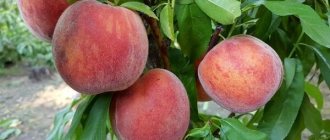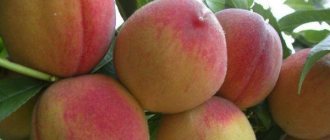It is difficult to imagine the abundance of fresh fruits without peaches and apricots. Popular in the summer, they are one of the most common products on store shelves. Despite the apparent similarity of the fruits, peaches and apricots can be distinguished by many differences.
Peach and apricot are widespread mainly in the southern regions of Russia, since the plants do not have good frost resistance. Apricot belongs to the Plum genus of the Rosaceae family. Thanks to the work of breeders, several varieties of apricots suitable for the middle zone have been developed:
- Hardy - has oval golden fruits with a characteristic blush. You can harvest up to 80 kg of crop from one tree;
- Apricot Peach is a high-yielding variety. Fruits – 40-50 g, round, lumpy, with a slight depression. The description of the Peach apricot variety is characterized by a pineapple aroma of the pulp;
- Orlovchanin - ovoid yellow fruits with a carmine-red blush. They have good winter hardiness.
The first difference between a peach and an apricot is its genus; it is a member of the Almond genus. The most famous subspecies:
- Potanin's peach - belongs to the inedible wild varieties, grows in the wild in China;
- Guan peach - small, hard-fleshed fruits with an unattractive taste. The species is used as a basis for developing new varieties, imparting to them immunity to frost and resistance to diseases;
- Kiev early - characterized by its unpretentiousness to environmental conditions, bears fruit with elongated pale yellow fruits, the average weight of which is 100 g;
- Druzhba is a frost-resistant variety that produces round, yellowish-cream fruits weighing 150-250 g.
Potanin's Peach
Suitable for central and northern regions
A mixture of apricot and peach with aromatic and juicy pulp.
Photo: fermer.blog Characteristics:
- A hybrid of peach and apricot includes the taste qualities of both parents. Externally, the fruit looks like an apricot, and its size is like a peach. The height of the tree does not exceed 3 m, the leaves are like those of an apricot, but taper like those of a peach. The main advantage of the crop is its frost resistance and high yield.
- Breeders have also developed other hybrids obtained by crossing plums and apricots, cherries and plums, apples and peach. Such combinations are not only unusual, but also produce interesting fruits with different tastes and uses.
- The efforts of scientists are aimed at obtaining an ideal hybrid that produces crops in any area and climatic conditions. They give plants not only endurance, but also resistance to various diseases and pests, increased productivity and crown compactness.
- The main goal of scientists is attractive crops that produce high-quality fruits. Along with the advantages, the bred crop has disadvantages, such as a short life expectancy, demanding soil composition and the inability to obtain seeds from the bred species.
Crossing fruit trees has provided new directions for the development of resistant varieties.
Photo: fermer.blog The author of the video talks about new hybrids that have excellent frost resistance and unusual taste. Sharafuga is a hybrid of early-fruiting and large-fruiting. The advantages are resistance to diseases and pests, as well as a large harvest from one tree:
Features of hybrids
All hybrids inherit the best features of their parent trees. The taste of nectarines is most similar to an apricot, but in size they are more like a peach. The uniqueness of hybrids lies in the following features:
- trees grow small: average height is 2-3 m, no more; if we are talking about a seedling, then the ideal height for planting is one m;
- there should be at least 3.5 m of free space around the tree, since the hybrid has a wide crown, but insufficient height;
- the leaves of the tree are shaped like peach leaves - they are bright green, smooth, gradually tapering from the base to the edge;
- with good care, constant watering and fertilization, the tree will live for more than 10 years;
- if the hybrid contains more apricot DNA, then the fruits have bright orange “cheeks”, sometimes red.
Many experts advise choosing a warm season for planting such trees. It is best to do this in early July or late August. There are other options. This could be the time period from March to May, or from the beginning of September to November. If you plan to plant a tree before the first frost, do not forget to prepare the root system and branches of the plant for cold weather.
Maturation period
Most often, the fruit ripening period falls in September, so all varieties are classified as types of trees that bear fruit late. To get a high percentage of yield, plant plants only in sunny areas. Maintain a distance of 4 meters between trees.
It is very important to prune sufficiently large shoots in a timely manner.
Diseases and pests
| Bacterial and fungal diseases Ways to fight:
| |
| Pests Ways to fight:
|
Care
Hybrid varieties are very demanding when it comes to balanced watering. They are intolerant to drought, but waterlogging of the root system also has a detrimental effect on them. Therefore, taking into account local climatic and weather conditions, it is necessary to develop an irrigation algorithm that would prevent a lack of moisture in the soil and at the same time prevent its waterlogging.
In addition, each watering and each post-rain period must be combined with loosening the soil. This operation prevents the formation of a crust on the ground, which interferes with the full supply of oxygen to the root system. The creation of optimal temperature and humidity conditions in the soil is facilitated by mulching the tree trunk circle with dry humus, sawdust or crushed peat.
The crown of hybrid trees also requires care. Formative and sanitary pruning involves removing dried, diseased or damaged branches in the fall or early spring before sap begins to flow, as well as shortening the main branches and eliminating excess shoots that excessively thicken the crown.
All types of hybrid trees, as already mentioned, are demanding on soil fertility and, accordingly, require regular feeding with fertilizers, which is carried out during the growing season as follows:
- In the spring , immediately after the snow melts, the soil is enriched with nitrogen fertilizers, which stimulate the growth of green mass. Organic fertilizers are rich in nitrogen, as well as ammonium nitrate and urea, which are applied per 1 m² at 25 g each.
- After the flowering period, the trees are fed by foliar feeding, for which, for example, the drug “Kemira-universal” is used, applied three times every 2 weeks.
In the fall, the tree trunk circle is dug up with the parallel addition of a couple of buckets of humus, compost or slurry.
Important! Being self-fertile, hybrid trees do not require outside pollinators.
Reviews from gardeners
Valervanych, Belskoe
In my northern Moscow region, cherry-plum hybrids of Canadian selection (Mainor and two other varieties) have been bearing fruit abundantly for ten years now and they are also very tasty - especially the variety with red flesh.
Source: forum.prihoz.ru
Olesya
Sharafuga is the result of crossing nectarine (a variety of peach with smooth fruits, without pubescence, apricot and plum. Despite the fact that it was bred in the south, the variety has increased resistance to cold, so it can be grown in almost any region. In appearance, the tree is larger everything looks like a plum.
Source: fialka.tomsk.ru
Description of the variety Sharafuga
This is one of the most popular hybrids. This variety combines plum, peach and apricot DNA. This makes it difficult to know what the fruit will taste like.
Most often, the fruits have the delicate texture of a peach, the color of a plum and the taste of an apricot.
All of them are purple in color, with juicy pulp and bright green leaves. When choosing a variety, it is necessary to take into account that its cultivation requires special conditions.
Sharafuga - purple hybrid fruits
Choosing a place and landing
The place should be well lit: all fruits should receive the same percentage of sunlight for good development and ripening. Take care of good protection from winds, especially northern ones.
The hole needs to be dug quite deep: 70x70x80. The roots of the tree should stick out 5-8 centimeters above the hole: the soil will then subside and the roots will grow in diameter.
Soil for planting
For these types of plants, it is important that all the soil is sufficiently fertile. Before planting a tree, it is completely dug up and nutrients, humus and fertilizers are added.
After planting, the plant will begin to absorb nutrients, so do not forget to fertilize the soil every few days. Give preference to superphosphates and potash fertilizers. Protect trees from severe frosts: they will not be able to withstand temperatures below 25 °C.
Watering and fertilizing
Sharofuga is a type of hybrid that simply cannot exist without constant watering. But do not overdo it, because high humidity harms the root system of the tree.
Before watering, check the soil: if it is wet, then there is no need to water yet. To prevent water from eroding the ground, make either a large circle around the diameter of the tree or small grooves. Their depth should be no more than 10-20 cm.
For watering, you can use a sprayer or watering can. It is necessary to ensure that the water gets directly to the roots, and they are located at a depth of 60-70 cm.
Nectarine
What fruit is everyone's favorite nectarine a hybrid of? Experts are confident that this fruit was obtained as a result of a mutation of peaches during self-pollination, that is, it is not a hybrid. However, there is another point of view, according to which nectarine was developed as a result of crossing peaches with plums.
Read more: Young apricot does not bloom: why and what to do. Apricot flowering, why apricot blooms but does not bear fruit, how to achieve fruiting How to know that an apricot will bloom
Externally, the fruit resembles a peach; the main difference is that the skin of a nectarine is smooth and has no lint. The pulp is quite hard. Color varies from light yellow to cherry shades. The fruits contain a large amount of vitamins and useful micro- and macroelements, including phosphorus, potassium, and vitamin A.
Specific characteristics
Hybrids are distinguished by their undeniable advantages: strong immunity, high productivity, and the ability to withstand severe frosts.
Advantages and disadvantages
The main advantages of hybrid varieties:
- frost resistance, which allows you to grow an apricot hybrid in areas with cold winters;
- delicious fruits rich in vitamins;
- disease resistance;
- unpretentiousness.
The sugar content in fruits is high - this is considered a disadvantage by people suffering from various diseases.
Features of the tree
Hybrid trees can grow 2–2.5 m in height - they are low fruit crops. The appearance of the leaves depends on the type of hybrid crop: aprium looks like an apricot tree, pluot looks like a plum tree.
Fruit quality and yield
Large oval fruits, the weight of some of them can reach 70 g. Apricot, crossed with plum, has a different color depending on the variety: purple, yellow, pink, burgundy, greenish.
Some fruits have an apricot flavor and are similar in appearance to plums. Others taste like plums. Inside is juicy and sweet fibrous pulp of yellow, purple or violet color, with a stone. The thin and smooth skin is slightly covered with a waxy coating. Sometimes there is slight pubescence on the surface. In everyday life, such hybrids are also called “purple apricots.”
In the first two years of life, hybrids do not bear fruit. But gradually the yield will increase - proper tree care also plays an important role in this. One mature tree can produce 30–40 kg of fruit. Fruits usually ripen by August. But you can also collect fruits that are not fully ripened - they are placed at home in a suitable place where they ripen.
Winter hardiness, disease resistance
Hybrid trees successfully tolerate severe frosts (up to 35°C), but react negatively to thaws in the winter months.
Thanks to their strong immunity, they are rarely attacked by pests and infectious diseases.
In the spring, before the trees bloom, you can carry out preventive spraying with fungicidal preparations (Bordeaux mixture is suitable).
Grapefruit
Do you know what the grapefruit is a hybrid of? It was obtained by crossing oranges with pomelo, although the birth of this hybrid occurred without human intervention. In fact, the crossing occurred naturally, and the fruits were discovered in 1750 in Barbados completely by accident.
The fruits got their name for a reason, because they grow in large clusters. Because of this, grapefruit was given the name “grape fruit.” The fruits may have a yellow, orange, or reddish color. There are even varieties with white and pink skin! The color of a grapefruit does not affect the taste of the fruit.
The hybrid brings great benefits to humans, because it stabilizes metabolism and has a positive effect on overall well-being. No wonder they recommend eating it if you want to get rid of extra pounds. In addition, red and pink varieties of grapefruit have a higher content of vitamin A.
Read more: Budra ivy creeping dogmint

